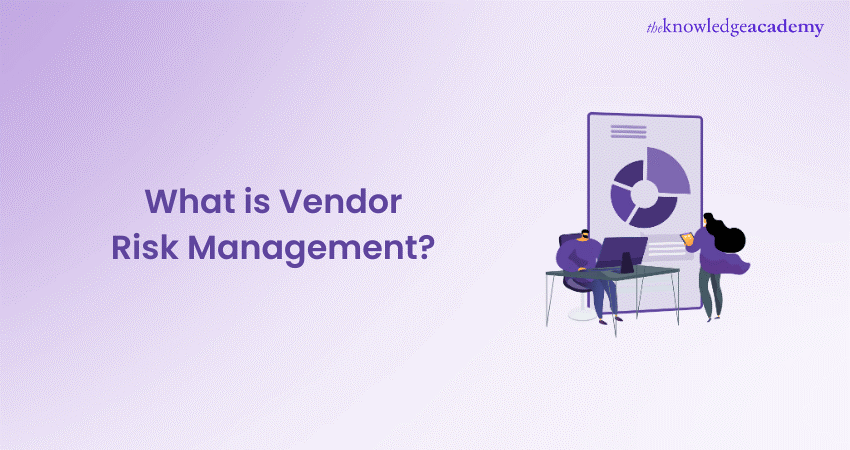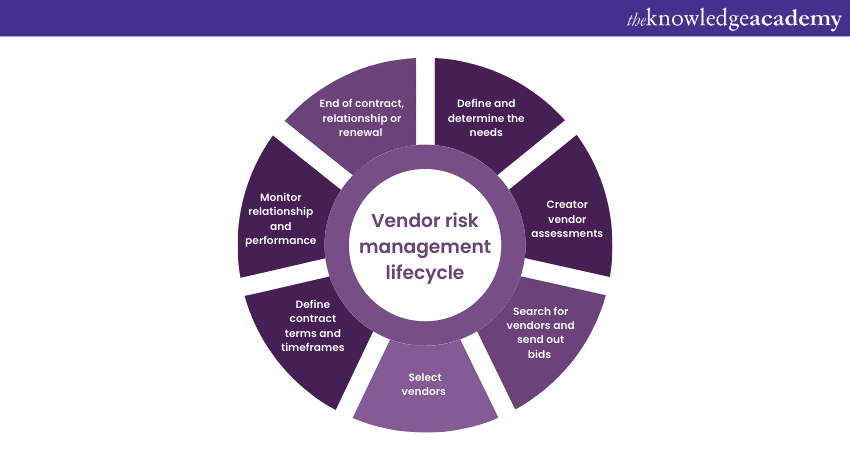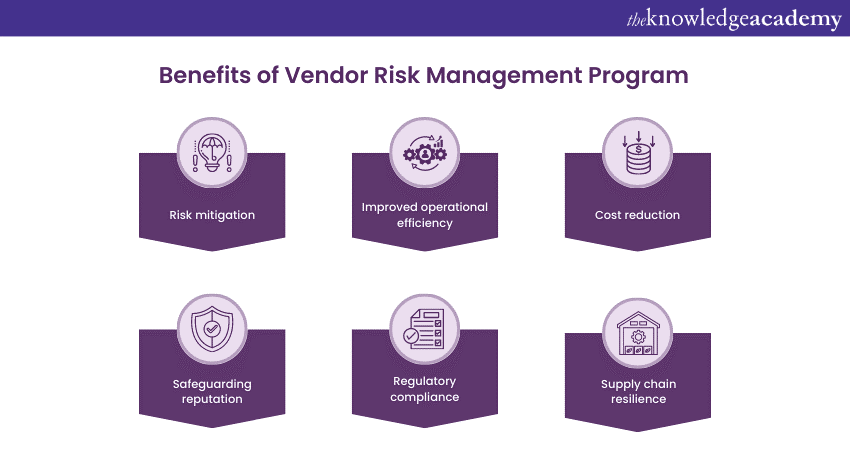We may not have the course you’re looking for. If you enquire or give us a call on 01344203999 and speak to our training experts, we may still be able to help with your training requirements.
Training Outcomes Within Your Budget!
We ensure quality, budget-alignment, and timely delivery by our expert instructors.

Are you aware of the risks involved in managing vendor relationships? If not, let us explain you in this blog. Vendor Risk Management (VRM) is the key to safeguarding your business. By evaluating the risk profiles of business partners, suppliers, or third-party vendors both before and during your contracts, you can protect your operations from potential disruptions.
Imagine a business environment where disruptions, financial impacts, and reputational damage are minimised. Implementing a VRM ensures that risks are identified and managed throughout the entire vendor lifecycle, including off-boarding. This proactive approach secures smooth and secure business operations, mitigating risks and protecting your company’s interests.
Take control of your vendor relationships today by implementing a robust Vendor Risk Management Program to ensure your business runs smoothly and securely. Read this blog to learn more about Vendor Risk Management and how it can benefit your business.
Table of Contents
1) What is Vendor Risk Management?
2) Why is Vendor Risk Management important?
3) Vendor Risk Management lifecycle
4) Creating an effective Vendor Risk Management framework
5) Benefits of Vendor Risk Management
6) Conclusion
What is Vendor Risk Management?
VRM is a strategic process that organisations use to identify, assess, and mitigate the risks associated with their third-party vendors, suppliers, and service providers. It’s an important part of an organisation’s overall Risk Management strategy and Cyber Security efforts. Here’s what it typically involves:
a) Risk identification: Spotting potential risks that could arise from working with vendors, such as Data Breaches or supply chain disruptions.
b) Risk assessment: Evaluating the likelihood and impact of these risks on the organisation.
c) Risk mitigation: Implementing controls and measures to reduce identified risks to acceptable levels.
d) Vendor due diligence: Conducting thorough background checks and security assessments before engaging with a new vendor.
e) Contract management: Ensuring that contracts with vendors include clauses that protect the organisation’s interests, particularly around data security and compliance.
f) Continuous monitoring: Keeping an ongoing watch on vendor performance and compliance with the organisation’s policies and standards.
The goal of VRM is to ensure that the organisation’s vendors do not pose a threat to its financial, operational, reputational, or Cyber Security posture.
By effectively managing these risks, organisations can maintain robust security practices and foster strong, secure, and mutually beneficial relationships with their vendors.
Who is a Vendor?
Understanding the role of a vendor is crucial in Vendor Risk Management. Vendors are external entities that supply goods, services, or technology to an organisation. They play a vital role in its smooth operation and ensuring adequate stock levels.
Despite their valuable contributions, vendors can also pose significant risks if not properly managed. Vendors come in various forms, including:
a) Suppliers: Every company needs raw materials, components or finished products to run efficiently. Suppliers ensure supplying these products on time. They are a powerful factor in the chain and could easily downgrade the quality and availability of products or services.
b) Service providers: Business entities hire services from other companies to provide IT consulting, in-house law, marketing, cleaning service, or facilities management.
c) Contractors: Companies often contract individuals or expert firms to complete specific tasks or projects on their behalf. These contractors can be specialists in fields such as construction, engineering, app development, or other specialised skills.
d) Technology providers: The technology companies create Software Applications, hardware, cloud services, or another technology related products that could serve the organisation information technology infrastructure and operations. They acquire privileged access to sensitive data or significant systems; therefore, Risk Management involving them is quite crucial.
e) Outsourced providers: Many organisations are now choosing a solution that shifts certain business activities or functions to external vendors. These functions could include payroll processing, customer service support and logistics.
Why is Vendor Risk Management important?
Vendor Risk Management (VRM) is crucial for several reasons. Some of them are mentioned below:
a) Protects sensitive data: Vendors often have access to sensitive and confidential information. Effective VRM ensures that vendors adhere to data protection standards, reducing the risk of data breaches.
b) Maintains compliance: Many industries are subject to stringent regulatory requirements. VRM helps organisations ensure that their vendors comply with relevant laws and regulations, avoiding legal penalties and fines.
c) Reduces operational Risks: Vendor-related disruptions can significantly impact an organisation’s operations. VRM helps identify and mitigate risks associated with vendor performance, ensuring business continuity.
d) Safeguards reputation: Vendor issues, such as data breaches or non-compliance, can damage an organisation’s reputation. Proactive VRM helps protect an organisation’s brand and maintain customer trust.
e) Ensures quality and reliability: Regular assessment of vendors ensures they meet the organisation’s quality standards and performance expectations, leading to more reliable and efficient operations.
f) Financial protection: VRM helps in identifying financial risks related to vendors, such as financial instability or hidden costs, protecting the organisation from potential financial losses.
g) Enhances strategic relationships: By managing vendor risks effectively, organisations can build stronger, more strategic relationships with their vendors, fostering collaboration and innovation.
Learn the essentials of Program Management and understand how to evaluate KPIs to monitor benefits throughout the Program lifecycle with the Program Management Professional (PgMP)® training
Vendor Risk Management Lifecycle
A well-structured Vendor Risk Management (VRM) strategy should cover the entire vendor relationship period. Organisations can effectively manage and prevent risks by systematically addressing the various phases of the vendor lifecycle. Let's explore the key steps involved in the Vendor Risk Management lifecycle:

Define and determine the needs
Vendor Risk Management lifecycle is started precisely when the organisation has clarified all its needs and wants. This entails the identification of the specific products or services from which the company needs to procure from the Vendors.
Create assessments for all vendors
The evaluations perform the risks' analysis using the defined criteria, such as information security practices, financial stability, regulatory compliance, and business resilience. The kind of assessments can be an evaluation using questionnaires, audits or onsite review to gather all the necessary data concerning the risk profile of the vendor.
Search for vendors and send out bids
Companies need to establish criteria for selecting the best service providers and then hire them. Strategies for this process include seeking referrals, conducting industry research, and issuing Requests for Proposals (RFPs). Vendors play a crucial role by helping bidders develop proposals that address the unique needs and risks of the organisation.
Select vendor(s)
Procurement involves comparing quotations or proposals provided by vendors that meet organisational needs. Fine-tuning vendor rating records and checking references and backgrounds are central to making prudent decisions when selecting vendors. This ensures they align with all organisational requirements.
Learn the basic principles of Project Management with the PMP® Certification!
Define contract terms and timeframes
Vendor selection is followed by negotiating contract terms and setting deadlines. Transparent contracts that clearly outline a vendor's responsibilities, deliverables, performance parameters, Risk Management, data protection, confidentiality, and dispute resolution are essential. Ensuring alignment on language and timelines is crucial to avoiding disputes and misunderstandings.
Monitor relationship and performance
Vendor Risk Management encompasses more than just a set of activities involving vendor selection; it also includes overseeing the vendor’s performance and relationship with the client. This involves monitoring to ensure the fulfilment of contract requirements, provisions, service levels, and Risk Management methods.
End of contract, relationship, or renewal
The first step of Vendor Risk Management occurs at the point of contract renewal or termination. Organisations evaluate vendors based on their performance, risk mitigation, and ability to respond to changing requirements. This assessment helps determine whether to renew, terminate, or renegotiate the contract.
Creating an Effective Vendor Risk Management Framework
Risk Management framework is a set of policies and processes designed to evaluate and manage the risks associated with a business’s third-party vendors. An effective Risk Management framework enables businesses to analyse, assess, and monitor risk exposure at every stage of the supplier's lifecycle. To create an effective framework, you should:
a) Establish a list of all third-party vendors, including those responsible for providing products, services, or data to your organisation.
b) Evaluate each vendor's risks, including data leakages, financial fraud, and compliance breaches.
c) Develop mitigation procedures, such as installing security measures, performing due diligence, or negotiating contract terms.
d) Create monitoring control measures and reports. This will allow you to track the success of your risk mitigation strategies and identify any new risks that may emerge.
An effective framework, therefore, cannot be a one-time solution. It must be continuously updated in line with your organisation’s evolving risk portfolio.
The difference between a linear and ongoing Vendor Risk Management model
A linear Vendor Risk Management model is a traditional approach that focuses on assessing risks at specific stages of the vendor lifecycle, such as during procurement or contract negotiations. However, an ongoing Vendor Risk Management model takes a more continuous approach by monitoring risks throughout the entire lifecycle.
The ongoing Vendor Risk Management model has several advantages over the linear model, including:
a) It offers a broader view of risk.
b) It enables the identification and reduction of risks at the earliest stages.
c) It is more efficient, faster, and cost-effective.
Learn the essential skills to effectively implement the business analysis frameworks with the PMI Project Management Ready Training.
Benefits of Vendor Risk Management

Implementing a robust Vendor Risk Management Program offers several significant benefits to organisations. Let's explore some of the key advantages:
Risk mitigation and protection
A good Vendor Risk Management enables companies to address risk-related issues with vendors effectively. Through rigorous due diligence and assessment mechanisms, weaknesses are identified and resolved, reducing the number of disruptions, financial losses, legal issues, and reputational damage.
Improved operational efficiency
An efficient Vendor Risk Management system ensures that vendors comply with the company's operational expectations and obligations. Continuous monitoring and evaluation help identify issues at an early stage, allowing timely resolution of complications with vendors.
Cost reduction
Vendor Risk Management efforts enable companies to optimise costs through risk assessment and favourable terms and pricing structures. Quality management serves as a budget-saving tool by reducing the costs of unexpected failures from vendor issues or breaches, helping to keep expenditures under control.
Safeguarding reputation
Vendors’ responses play a critical role in establishing an organisation’s reputation. Active Vendor Risk Management not only safeguards reputation but also creates supportive environments that lead to the success of customers and stakeholders.
Regulatory compliance
Comprehensive Vendor Risk Management ensures that vendors comply with rules such as data privacy and anti-corruption. This minimises risks arising from regulations and unethical practices, demonstrating the company’s commitment to ethics.
Continuity and resilience
Companies review suppliers' continuity plans to prevent interruptions. Identifying and addressing weaknesses helps decrease vulnerability to situations like technical glitches or natural disasters, thereby maintaining operational continuity.
Conclusion
Vendor Risk Management is a critical component of organisational Risk Management strategies. By implementing robust VRM practices, organisations can protect sensitive data, maintain business continuity, and safeguard their reputation. A proactive VRM program involves continuous monitoring, regular assessments, and collaboration with vendors to address potential risks easily.
Learn all the methodologies of Project Management in detail with our Project Management Courses!
Frequently Asked Questions

Risk exchanges are platforms where organisations access, share, or buy risk-related information. This helps comprehensive vendor risk assessments through data access, benchmarking, real-time monitoring, collaboration, and customisable analytics.

Common challenges in Vendor Risk Management careers include data quality, regulatory compliance, due diligence complexity, risk assessment intricacy, Vendor Relationship Management, emerging risks, communication, monitoring, resource constraints, and vendor dependency.

The Knowledge Academy takes global learning to new heights, offering over 30,000 online courses across 490+ locations in 220 countries. This expansive reach ensures accessibility and convenience for learners worldwide.
Alongside our diverse Online Course Catalogue, encompassing 17 major categories, we go the extra mile by providing a plethora of free educational Online Resources like News updates, Blogs, videos, webinars, and interview questions. Tailoring learning experiences further, professionals can maximise value with customisable Course Bundles of TKA.

The Knowledge Academy’s Knowledge Pass, a prepaid voucher, adds another layer of flexibility, allowing course bookings over a 12-month period. Join us on a journey where education knows no bounds.

The Knowledge Academy offers various PMP® Training, including PMP® Certification Training, Certified Associate in Project Management (CAPM)® Course and Project Management Institute Agile Certified Practitioner (PMI-ACP) ® Training. These courses cater to different skill levels, providing comprehensive insights into What is PMP in Healthcare.
Our Project Management Blogs cover a range of topics offering valuable resources, best practices, and industry insights. Whether you are a beginner or looking to advance your Project Management skills, The Knowledge Academy's diverse courses and informative blogs have you covered.
Upcoming Project Management Resources Batches & Dates
Date
 PMP® Certification Training Course
PMP® Certification Training Course
Mon 28th Oct 2024
Sat 2nd Nov 2024, Sun 3rd Nov 2024
Mon 4th Nov 2024
Mon 11th Nov 2024
Sat 16th Nov 2024, Sun 17th Nov 2024
Mon 18th Nov 2024
Mon 25th Nov 2024
Sat 30th Nov 2024, Sun 1st Dec 2024
Mon 2nd Dec 2024
Mon 9th Dec 2024
Sat 14th Dec 2024, Sun 15th Dec 2024
Mon 16th Dec 2024
Mon 6th Jan 2025
Mon 13th Jan 2025
Mon 20th Jan 2025
Mon 27th Jan 2025
Mon 3rd Feb 2025
Mon 10th Feb 2025
Mon 17th Feb 2025
Mon 24th Feb 2025
Mon 3rd Mar 2025
Mon 10th Mar 2025
Mon 17th Mar 2025
Mon 24th Mar 2025
Mon 31st Mar 2025
Mon 7th Apr 2025
Mon 14th Apr 2025
Tue 22nd Apr 2025
Mon 28th Apr 2025
Tue 6th May 2025
Mon 12th May 2025
Mon 19th May 2025
Tue 27th May 2025
Mon 2nd Jun 2025
Mon 9th Jun 2025
Mon 16th Jun 2025
Mon 23rd Jun 2025
Mon 30th Jun 2025
Mon 7th Jul 2025
Mon 14th Jul 2025
Mon 21st Jul 2025
Mon 28th Jul 2025
Mon 4th Aug 2025
Mon 11th Aug 2025
Mon 18th Aug 2025
Tue 26th Aug 2025
Mon 1st Sep 2025
Mon 8th Sep 2025
Mon 15th Sep 2025
Mon 22nd Sep 2025
Mon 29th Sep 2025
Mon 6th Oct 2025
Mon 13th Oct 2025
Mon 20th Oct 2025
Mon 27th Oct 2025
Mon 3rd Nov 2025
Mon 10th Nov 2025
Mon 17th Nov 2025
Mon 24th Nov 2025
Mon 1st Dec 2025
Mon 8th Dec 2025
Mon 15th Dec 2025
 Halloween sale! Upto 40% off - 95 Vouchers Left
Halloween sale! Upto 40% off - 95 Vouchers Left







 Top Rated Course
Top Rated Course



 If you wish to make any changes to your course, please
If you wish to make any changes to your course, please


